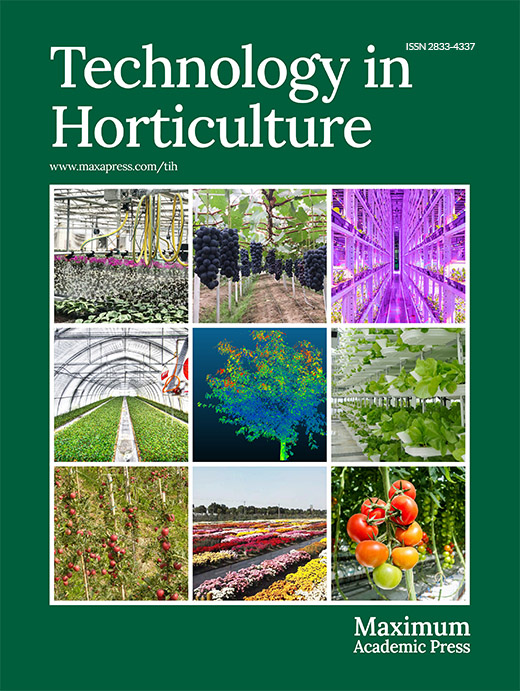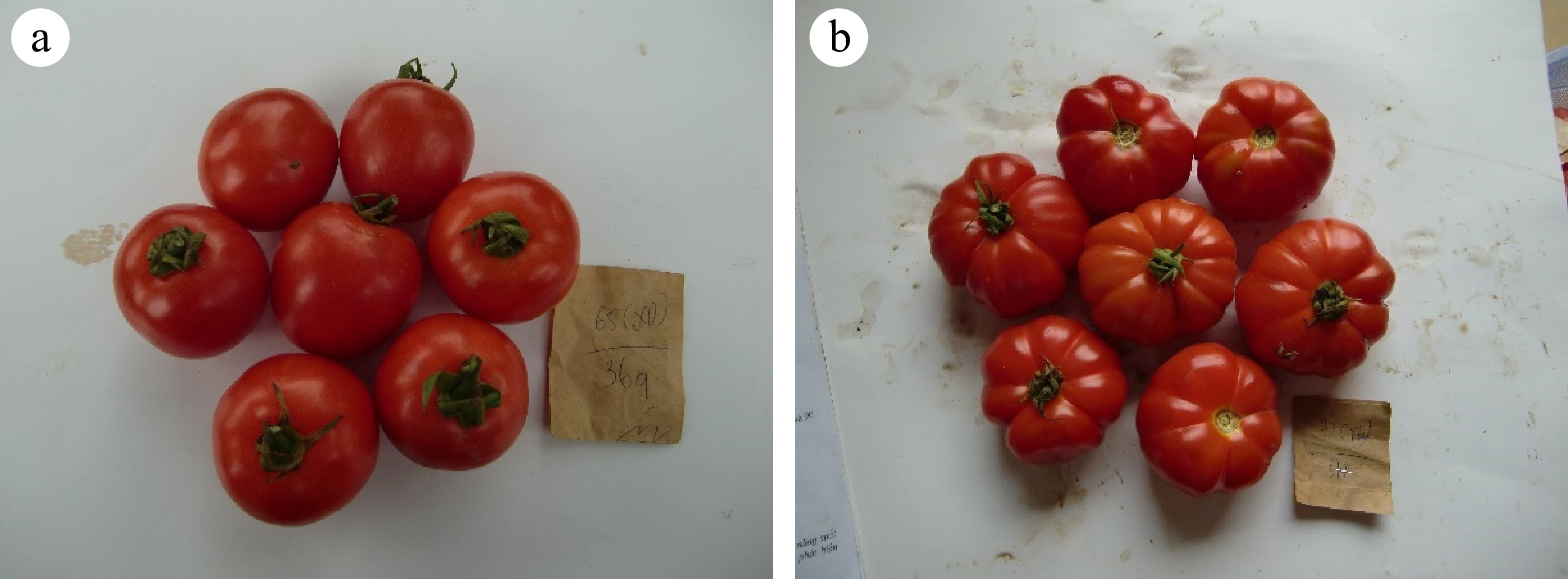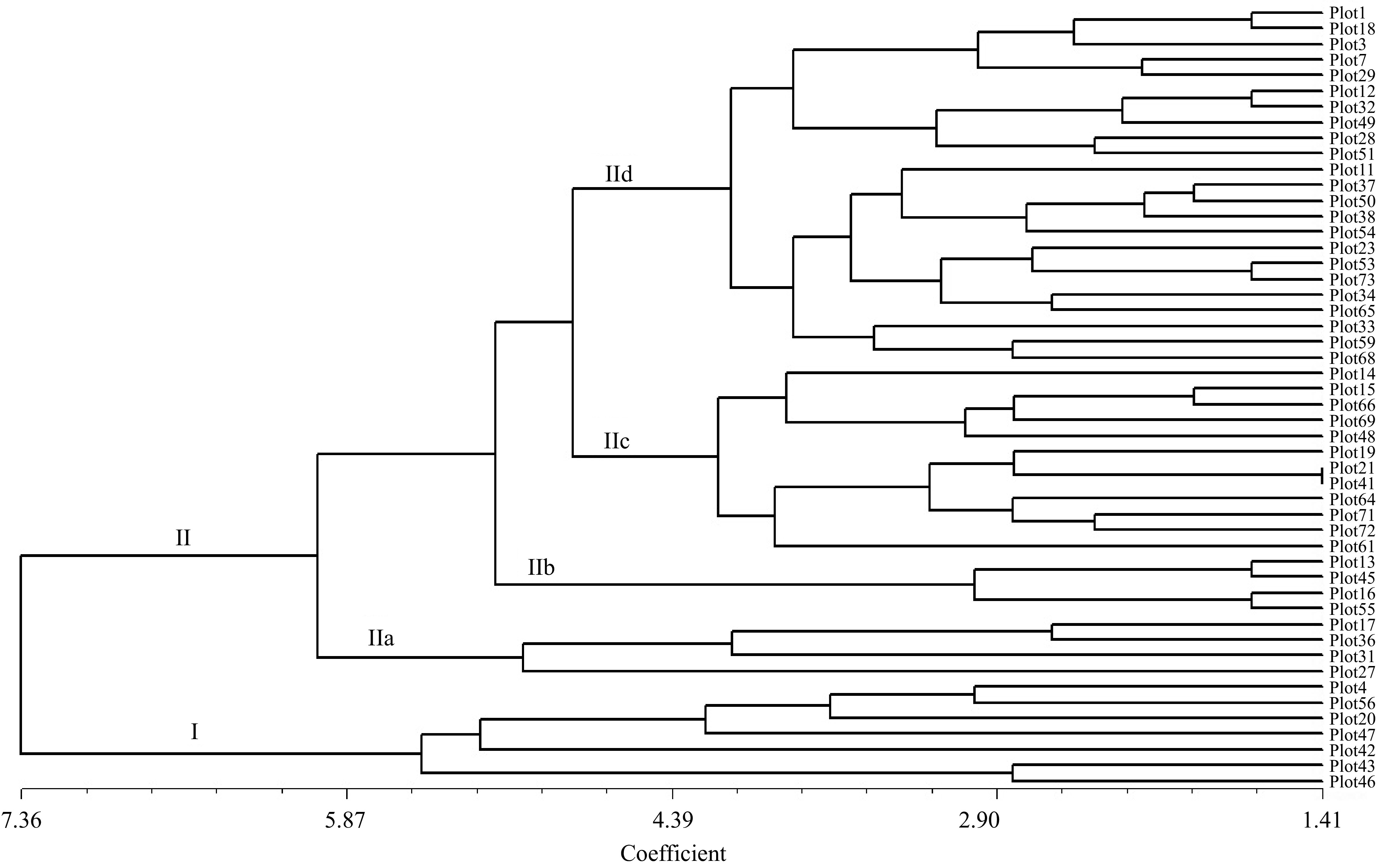-
Tomato (Solanum lycopersicum Linn.) is not just a fruit vegetable; it's a nutritional powerhouse. Packed with vitamins, sugars, minerals, lycopene, and β-carotene, tomatoes have significant health benefits. Tomatoes are versatile, finding their way into our daily meals in both fresh and cooked forms. Their significance doesn't end there. They're also a key ingredient in the food processing industry, used to make concentrated tomatoes, tomato paste, dried tomatoes, and whole canned tomatoes, among other products.
Worldwide, tomatoes are one of the leading large-planted staple vegetables with 4.92 million hectares globally in 2022, yielding 186 million tons[1]. In Vietnam, tomatoes have become a vital fruit vegetable prioritized for development with a total planting area of about 23−25 thousand hectares, not only concentrated in the Northern Delta and Midlands but also expanding to the Central, Central Highlands, and Southern provinces[2].
Currently, tomatoes grown in Vietnam are mostly imported varieties, F1 hybrids, and a few local varieties. Imported varieties or F1 hybrids often yield high and have beautiful fruit designs, but the limitation is that the seed price is very high, and sometimes they show poor adaptation, especially in erratic climatic weather conditions in recent years. Conversely, despite lower yields, many local tomato varieties exhibit excellent fruit quality and resilience against pests, diseases, and adverse weather. In the spring-summer 2023 season, 50 tomato accessions were conserved at the National Plant Genebank belonging to the Plant Resources Center (An Khanh, Hoai Duc, Hanoi, Vietnam), were evaluated for morphological and agronomic characteristics. This research result is the basis for the following step: selecting quality tomato varieties with a long harvest time, contributing to diversifying the varieties in production.
-
Materials included 50 tomato accessions collected in the central production regions in the country and at domestic and foreign research facilities are conserved at the National Plant Genebank - Plant Resources Center, An Khanh commune, Hoai Duc district, Hanoi City, Vietnam (Table 1).
Table 1. List of the tomato collection evaluated in 2023.
No. Name of accessions Genebank code Plot number No. Name of accessions Genebank code Plot number 1 Ca chua Ba Lan 3730 1 26 Ca chua 13507 38 2 Ba Lan 5682 3 27 Ca chua mui 13692 41 3 Caracolli 5684 4 28 Ca chua 13698 42 4 CL 5915 - 223 D4 -2-1-0 dang 1 5698 7 29 CLN 2714J 13699 43 5 CLN 475 BC 1F2 265-9-0 dang 1 5718 11 30 CLN 2413R 15424 45 6 FMTT 277 dang 1 5723 12 31 CLN 2418A 15425 46 7 FMTT 572 dang 1 5725 13 32 Ca chua 15430 47 8 FMTT 589 dang 1 5726 14 33 Ca chua VT3 15440 48 9 Hong lan 5736 15 34 CL35 16416 49 10 Xivia 5740 16 35 Ca chua 16419 50 11 Ca chua 5744 17 36 HT160 16423 51 12 Ca chua Hong Lan 5748 18 37 CLN 2237B 21925 53 13 Ca chua ta dang 1 6888 19 38 11Ca07 T22618 54 14 CLN 2026E 7466 20 39 13Ca01 T22630 55 15 Ca chua leng 7469 21 40 13Ca02 T22631 56 16 CL 1351 D 7508 23 41 Carioca 5686 59 17 Mini yellow 7518 27 42 CLN 1621-235-2-0 5711 61 18 CL8 7519 28 43 Ca chua 5745 64 19 CL18 7524 29 44 CLN 1621F 7467 65 20 CL32 7526 31 45 CLN 1466M 7672 66 21 CL38 7527 32 46 Ca chua Thai Lan 1 13510 68 22 Hooc mon 7671 33 47 CL1351 B 13691 69 23 CLN2026D (sure check) 8438 34 48 PLATENSE UCO-102N+VMT 15427 71 24 Kiem lung pieu 9550 36 49 Ca chua 15429 72 25 Ca chua 13504 37 50 CLN 2714H 15431 73 The experiment was arranged according to the group planting method: the plot was arranged sequentially without repeating, the area of each experimental plot was 20 m2, and the planting density is 40 plants/plot equivalent to 20,000 plants per ha. Sow seedlings in trays and plant them in the field when the plant is 20 d old, with 5−6 true leaves.
The research methods are National Technical Standards and Testing for tomato plants, including QCVN 01-63:2011/BNNPTNT and QCVN 01-70:2011/BNNPTNT. Describe and evaluate agro-morphological traits of 50 tomato accessions according to National Technical Regulation on Testing for Value of Cultivation and Use of Tomato varieties QCVN 01-63:2011/BNNPTNT[3]; National Technical Regulation on Testing for Distinctness, Uniformity and Stability of Tomato Varieties QCVN 01-70:2011/BNNPTNT[4], and characterization and preliminary evaluation for tomatoes issued by the Plant Resources Center[5].
Statistical analysis
-
Collecting data and statistics analysis by Excel 2016 software, including Mean, Minimum, Maximum, Standard deviation (SD), coefficient of variation (CV%), and n values for quantitative traits.
The study was conducted during the Spring−Summer crop 2023 in the National Genebank of the Plant Resources Center (PRC), located in An Khanh commune, Hoai Duc district, Hanoi city, Vietnam. Geographically, the study site is positioned at 21°01'30" N latitude and 105°43'32" E longitude, with an elevation of 3.9 m above sea level.
-
The findings from this study on the growth and development characteristics of tomato varieties are critical. They are the foundation for suggesting appropriate farming techniques, organizing crops, and establishing a rational crop rotation system to maximize production efficiency. Detailed results from this comprehensive study, which evaluated the growth and development characteristics of 50 tomato varieties during the Spring-Summer 2023 crop, can be found in Table 2. The list of all the tomato accessions and evaluated morphological and agronomic traits is given in Supplementary Table S1.
Table 2. Characteristics growing and development of 50 tomato accessions evaluated in spring–summer crop 2023 at An Khanh, Hoai Duc, Ha Noi, Vietnam.
Characteristics Statistical variations Levels (d) No. of accessions Percentage Accessions Planting to flowering (d) Min = 38 < 45 27 54% Plot 7, 20, 34, 41, 61... Max = 58 45–50 13 26% Plot 15, 17, 27, 42, 49, 66... Mean = 46 > 50 10 20% Plot 13,14,16, 68... SD = 5 CV (%) = 12 Planting to the first fruit harvesting (d) Min = 90 < 100 32 64% Plot 04, 20, 32, 31, 49,51, 56, 66... Max = 104 ≥ 100 18 36% Plot 16, 68, 69... Mean = 100 SD = 4 CV (%) = 4 Time for fruit harvesting (d) Min = 8 < 10 6 12% Plot 11, 15, 33 ,43, 46, 48... Max = 32 18–25 43 86% Plot 04, 20, 32, 49, 51, 56, 68, 69... Mean = 19 > 30 1 2% Plot 42 SD = 5 CV (%) = 25 Maturing (d) Min = 142 < 150 37 74% Plot 4, 20, 31, 32, 47, 66... Max = 156 ≥ 150 13 26% Plot 27, 45, 68, 69... Mean = 148 SD = 5 CV (%) = 3 Growth habit Determinate 12 24% Plot 20... Semi-determinate 22 44% Plot 4, 31, 32, 45, 47, 66, 69... Indeterminate 16 32% Plot 27, 68... Statistical analysis indicated that among the 50 tomato accessions studied, there were no significant fluctuations in maturing or time from planting to the first fruit harvest; the fluctuation coefficient of these two traits was only about 3%−4%. Meanwhile, the time from planting to flowering and the first fruit to the last fruit harvest (referred to as the fruit harvest time) of the studied varieties fluctuated quite a lot, with fluctuation coefficients of 12% and 25%, respectively.
The time from planting to flowering of the 50 tomato accessions ranged from 38 to 58 d. It is possible to divide these accessions into three groups based on the time from planting to flowering. Group 1 with less than 45 d from planting to flowering accounted for the majority with 27 accessions, equivalent to 54% of the total; the later flowering group 2 (45−50 d after planting) had 13 accessions, accounting for 26%, group 3 over 50 d after planting just flowered included ten accessions equivalent to the remaining 20%. After planting for 90−104 d, the tomato accessions produce the first fruit litter. Taking the time from planting to collecting the first fruit litter as 100 d as a milestone; it is possible to divide the tomato group into two groups; the group with the time from planting to the first fruit harvest of less than 100 d includes 32 accessions and the group with time from planting to first fruit harvest over 100 d consists of the remaining 18 accessions. Similarly, based on the growing time from sowing to collecting the final fruit, the studied accessions were classified into two groups: the group with an increasing time of less than 150 d, included 37 accessions, and the group with a growing time of more than 150 d including the remaining 13 accessions.
The study classified tomato plants into three growth phenotypes: determinate, semi-determinate, and indeterminate. The determinate growth pattern was characterized by the fact that when the plant gets 4−6 inflorescences and reaches a certain height, the last inflorescence appears at the top, after which the main stem stops growing. The semi-determinate phenotype is similar to the determinate growth pattern, but the number of inflorescences is more significant, with about 8−10 clusters. The indeterminate growth pattern has an indefinite plant height, the peak of which is flowering and leafing without stopping until the plant dies[6]. Of the 50 tomato accessions studied, there 12 determinate phenotypes, 22 semi-determinate phenotypes, and 16 indeterminate phenotypes. The fruit harvest time of the 50 accessions studied was variable, ranging from 8 to 32 d, and was divided into three groups. The group with an average fruit harvest period of 18−25 d accounted for a large proportion (86%) with 43 accessions, including indeterminate or semi-determinate growth habit. The group of accessions with a short harvest time accounts for less (12%) with six accessions. This group has a determinate growth habit, concentrated flowering, and fruits ripen simultaneously, so the time from collecting the first fruit to collecting the last fruit only takes about 8 d. The group with a long fruit harvest period (32 d) consists of one accession with an indeterminate growth habit.
In addition to the general assessment and grouping of research materials based on growth and development characteristics, 50 tomato accessions were also evaluated for fruit morphology (Table 3). This group of indicators is of great interest because they are directly related to consumer tastes. The results of observations evaluating fruit shapes show that the research group has four fruit shapes: flattened, flattened-round, round, and long round (Fig. 1). The number of accessions with flattened to rounded fruit shapes accounted for a high proportion, 62%, equivalent to 31 accessions; the round fruit form has 14 accessions, accounting for 28%. The long round fruit has five accessions, accounting for the remaining 10%. In the research group, the number of accessions belonging to the group of citrus tomatoes corresponding to irregular horizontal dimensions accounted for a small proportion (14%) with seven accessions. Their fruits are large, with many seed compartments (> five compartments), pulp flesh, and many others. In the group of fruits without citrus, the horizontal circular area accounted for a large proportion (86%) with 43 accessions, which the market prefers over the citrus form (Fig. 2).
Table 3. Fruit characteristics of 50 tomato accessions evaluated in spring–summer crop 2023 at An Khanh, Hoai Duc, Ha Noi, Vietnam.
Characteristics Levels No. of accessions Percentages Accessions Fruit shape in longitudinal section Flatted 26 13% Plot 14, 15, 66, 69... Flattened-round 36 18% Plot 1, 13, 32, 45, 46, 50, 73... Round 28 14% Plot 4, 49, 51, 56, 68... Round-long 10 5% Plot 17, 20, 31, 36, 47... Cross section of fruit Round 43 86% Plot 4, 27, 47, 66... Irregular 7 14% Plot 21, 41, 61, 64... Ripe fruit color Red 46 92% Plot 4, 20, 31, 32, 40, 45, 47, 66... Pink 2 4% Plot 56, 68 Yellow 2 4% Plot 27, 42 Interior flesh color Yellow 2 4% Plot 27, 42 Red 48 96% Plot 4, 20, 31, 32, 40, 45, 47, 66, 68... Fruit firmness Soft 21 42% Plot 27, 50, 59, 48 Medium 23 46% Plot 20, 32, 49, 51, 66, 68, 69 Hard 6 12% Plot 04, 16, 31, 45, 47, 55 Fruit flesh thickness (mm) < 5 5 10% Plot 19, 27, 36, 47 ≥ 5 45 90% Plot 4, 20, 31, 32, 66, 45 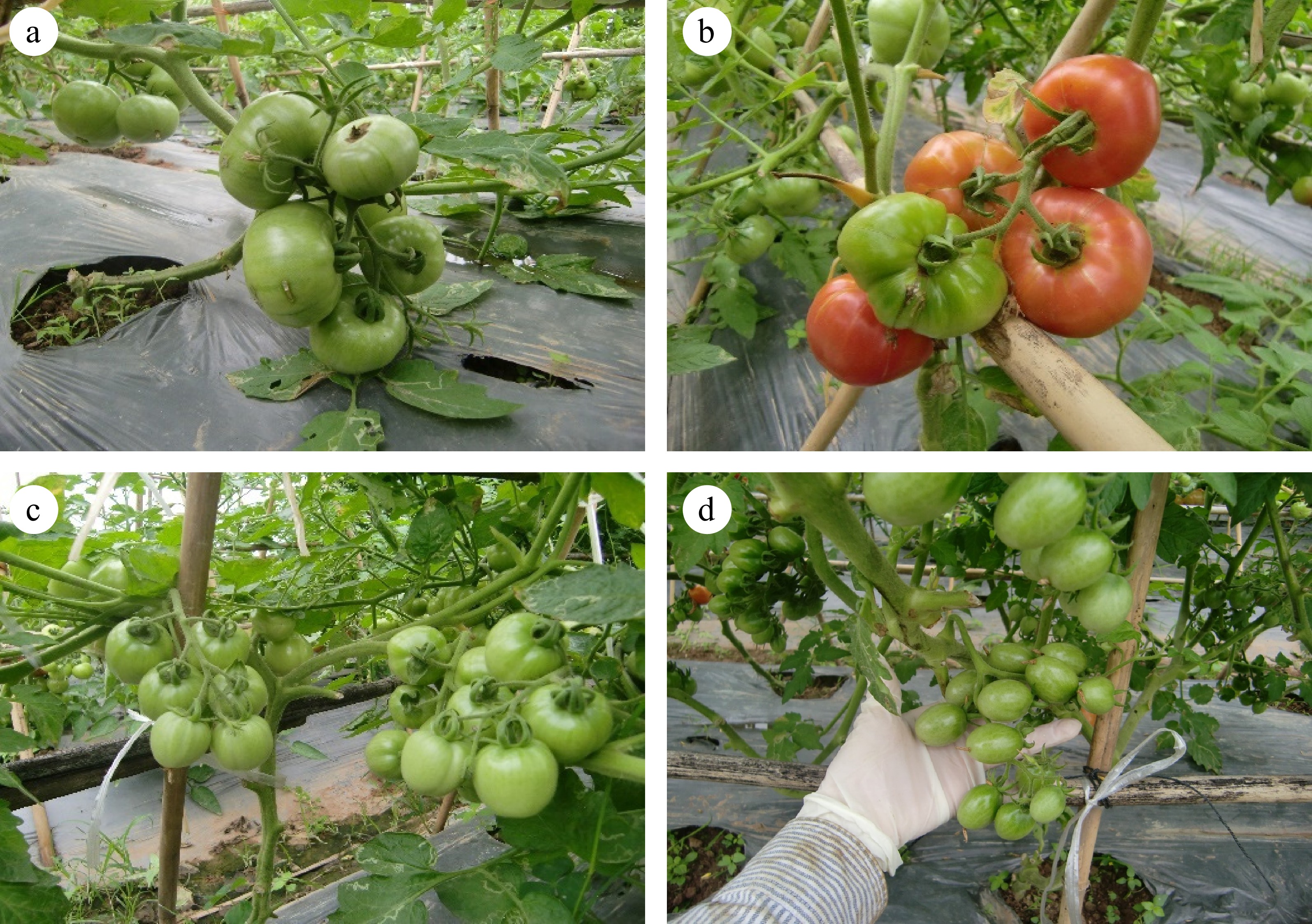
Figure 1.
Fruit shape in longitudinal section and normal shoots. (a) Flat (Plot 14). (b) Round-flat (Plot 50). (c) Round (Plot 51). (d) Round-long (Plot 17).
In addition to fruit shape, fruit color, and flesh color when ripe are also sensory attraction factors for users. The study and evaluation of fruit color characteristics of 50 accessions determined that 46 accessions of ripe fruit accessions were red, two accessions of ripe fruits were pink, and the remaining two accessions were ripe yellow (Fig. 3). Two accessions with ripe fruit color are yellow; the flesh is yellow, and the rest of the accessions are red flesh. The hardness of the fruit determines its bearing capacity. It is significant in choosing harvesting methods and storage methods to minimize the spoilage rate in transportation and post-harvest storage. Among the 50 studied accessions, six had solid fruit hardiness, easy to harvest, transport, and store; 23 accessions had average fruit hardiness; and 23 accessions with soft fruit hardness, easily crushed and damaged during and after harvest. The thickness of the flesh is one of the essential criteria for evaluating fruit quality and determining the hardness of the fruit. High flesh thickness will be favored in consumption and have good fruit hardness. The fleshy thickness of 50 accessions ranged from 3.7–9.9 mm, of which fruit flesh thickness of ≥ 5 mm (accounting for 90%) with 45 accessions. Evaluation of yield traits and some factors constituting the yield of 50 tomato accessions obtained the results presented in Table 4.

Figure 3.
Pipe fruit color of tomato collection. (a) Red (Plot 66). (b) Pink (Plot 68). (c) Yellow (Plot 27).
Table 4. Factors constituting productivity and productivity of 50 tomato accessions evaluated in spring–summer crop 2023 at An Khanh, Hoai Duc, Ha Noi, Vietnam.
Characteristics Statistical variations Levels No. of accessions Percentage Accessions Number of fruit/plant (fruits) Min = 7 < 15 5 10% Plot 13, 14, 23, 71 Max = 234 15–30 19 38% Plot 32, 45, 66, 72... Mean = 46 > 30 25 50% Plot 4, 27, 31, 47, 68... SD = 39 CV (%) = 86 Fruit weight (g) Min = 9 < 50 14 28% Plot 17, 27, 33, 36, 47 Max = 183 50–100 19 38 Plot 18, 29, 34, 46, 56 Mean = 81 > 100 g 17 34% Plot 4, 11, 32, 45, 66 SD = 45 CV (%) = 56 Plant yield (kg) Min = 1.1 ≤ 2.5 32 64% Plot 31, 42, 47, 66, 68... Max = 4.3 > 2.5 18 36% Plot 1,4, 32, 49, 69 Mean = 2.45 SD = 0.8 CV (%) = 33 Actual yield (tons/ha) Min = 16.5 ≤ 30 24 48% Plot 27, 22, 42, 47, 65 Max = 52.6 > 30 26 52% Plot 20, 28, 32, 66, 69 Mean = 32.3 SD = 9.5 CV (%) = 29 The number of fruits obtained per plant and the average weight varied widely between the tomato accessions studied. The average number of fruits per plant ranged from 7–234 fruits, and the average weight ranged from 9–183 g per fruit. According to Ta[6], based on the fruit's weight, tomatoes can be divided into three types: small, medium, and large fruits. The small fruits weighed less than 50 g, the medium fruits weighed about 50–100 g, and the giant fruits weighed over 100 g. The results of the tomato collection evaluation showed that there were 14 accessions belonging to the small fruit group and 19 accessions belonging to the medium fruit group. Accessions had small to medium fruiting; usually, the number of fruits per plant was large, over 30 fruits. The large fruits group (> 100 g) included the remaining 17 accessions, on average 15–30 fruits per plant, except an accession, with 5–8 fruits per plant, but the fruit shape was tremendous, and the average weight reached 183 g per fruit. In addition, the plant density factor, the number of fruits per plant (individual yield) plays a decisive role in the final yield per unit area (actual yield). Typically, accessions with high individual productivity will have good yield potential. Among the 50 accessions studied, 26 accessions reached over 30 tons/ha; most individual yields were over 2.5 kg/plant. The yield of the remaining 24 accessions reached less than 30 tons/ha, with individual yields from 1.0 to 2.5 kg/plant.
Genetic diversity assessment of 50 tomato accessions based on phenotype
-
After analyzing the data, the genetic distance of 50 tomato varieties was determined based on the evaluation score using NTSYS pc 2.11X software with the Euclidean similarity coefficient (a coefficient widely used in genetic diversity research, especially with phenotypic data). The genetic clustering tree was built based on the Euclidean genetic distance matrix using the UPGMA method (Fig. 4). Genetic distance matrix based on 26 agronomic morphological traits of the 50 tomato accessions is given in Supplementary Table S2.
According to the Euclidean genetic distance matrix among the 50 analyzed tomato varieties, the genetic distance of the varieties ranged from 1.41 to 9.38. The pair of varieties with the closest genetic distance was between Plot 21 and Plot 41, and the farthest was between five pairs of varieties, including Plot 19 and Plot 20, Plot 14 and Plot 47, Plot 21 and Plot 47, Plot 41 and Plot 47, Plot 47 and Plot 71. The average genetic distance of 50 tomato varieties was 5.15. Thus, based on this matrix, a genetic clustering tree will be constructed using the UPGMA method, resulting in two fairly straightforward groups at a genetic distance of 7.36 (Fig. 4). These two groups differ in the characteristic of 'easiness of peeling'.
• Group I included seven varieties with the easiness of peeling fruit characteristic at point 2 (medium). Plot 42, with a fruit flesh color score of 2 (yellow), differs from the remaining six varieties (score 5 - straw yellow). In addition, Plot 4 and Plot 47, with a leaf shape score of 3, differ from those in the group (score of 4). The ripe fruit color characteristic showed that Plot 42 (score 3-orange yellow) and Plot 56 (score 2-yellow), are different from the remaining varieties in group I (score 1). Similarly, the degree leaf dissection characteristics, Plot 20 (score 3-deep) and Plot 47 (score 1-slight) are different from the remaining varieties (score 2-medium) (Fig. 4).
• Group II included the remaining 43 varieties with the easy of peeling characteristic at point 7 (easy). This group was divided into four sub-clusters: IIa, IIb, IIc, and IId (Fig. 4).
(1) Sub-clusters IIa included four accessions Plot 17, Plot 27, Plot 31, and Plot 36. These accessions differed in maturation, stem type, fruit shape, thickness of fruit wall etc. Specifically, Plot 27 accession with completely different characteristics from the remaining Plot 17, Plot 31, and Plot 36 varieties, such as a fruit shape score 5 (heart-shaped), ripe fruit color score 3 (yellow) and interior flesh color score 2 (yellow). The Plot 27 accession has been separated from the three varieties Plot 17, Plot 31, and Plot 36, at genetic distances of 4.69, 5.92, and 4.58, respectively.
(2) Sub-clusters IIb consisted of four accessions divided into two pairs. The genetic distance of the Plot 13 and Plot 45 accessions is 1.73, with 23/26 similar characteristics. They differ only in the number of days from planting to flowering, fruit width, and number of fruit locules. Meanwhile, Plot 16 and Plot 55 accessions differ in growth type, number of leaves under the inflorescence, and fruit weight per plant.
(3) Sub-clusters IIc consisted of 12 accessions. Plot 21 and Plot 41 varieties have the shortest genetic distance (1.41). They had 25/26 similar characteristics, except days from planting to flowering.
(4) Sub-clusters IId consisted of 23 accessions with similar characteristics in degree leaf dissection score 2 (medium), leaf shape score 4, internode length score 3 (long), fruit section score 1 (round), and interior flesh color score 5 (straw yellow).
Results of initial selection of potential tomato varieties
-
Summarizing the study's results to evaluate the morphological and agronomic characteristics of 50 tomato accessions at the National Crop Genebank in Vietnam in the Spring−Summer crop of 2023, the research team initially selected ten potential accessions (Table 5) to conduct further selective evaluations. These accessions have good fruit quality and diverse and attractive shapes, sizes, and colors (Fig. 5); the time from planting to the first harvesting was 89−103 d, the fruiting rate was over 75%, the fruiting harvesting time lasted from 17−21 d, the fruit weight per plant ≥ 1.6 kg, fruit yield from 18 to 47.9 tons per ha. Field observations in the spring−summer 2023 season showed that these accessions were not infected or mildly infected with specific diseases such as late blight, yellow curl virus disease, and bacterial green wilt (Table 6).
Table 5. Characteristics of ten tomato accessions protential 2023.
No. Name of accession GC M
(d)PFH
(d)FR
(%)TH
(d)GH CF FFC FF Brix
(%)WF
(kg)FY
(ton/ha)1 Caracolli 5684 146 98 84 21 Semi-determinate Red Red Hard 4.8 3.4 47.9 2 CLN 2026E 7466 146 98 81 21 Determinate Red Red Medium 5.5 2.6 40.9 3 Mini yellow 7518 156 103 80 17 Indeterminate Yellow Yellow Soft 5.2 1.8 24.5 4 CL32 7526 146 98 85 21 Semi-determinate Red Red Hard 6.8 2.5 17.9 5 CL38 7527 146 98 78 21 Semi-determinate Red Red Medium 7.3 3.9 42.5 6 Ca chua Thai Lan 1 13510 156 103 86 17 Indeterminate Pink Red Medium 7.9 2.7 41.2 7 CLN 2413R 15424 156 103 78 17 Semi-determinate Red Red Hard 7.4 1.6 20.4 8 Ca chua 15430 146 98 91 21 Semi-determinate Red Red Hard 7.4 2.2 22.5 9 CLN 1466M 7672 146 89 78 21 Semi-determinate Red Red Medium 7.1 2.0 31.8 10 CL1351 B 13691 156 103 75 17 Semi-determinate Red Red Medium 7.2 2.9 39.4 GC: Genebank code; M: Maturing; PFH: Planting to the first harvesting; FR: Fruiting rate; TH: Time for harvesting; GH: Growing habit; CF: Color Fruit; FFC: Fresh fruit color; FF: Fruit firmness; WF: Weight of fruit/plant; FY: Fruit yield. 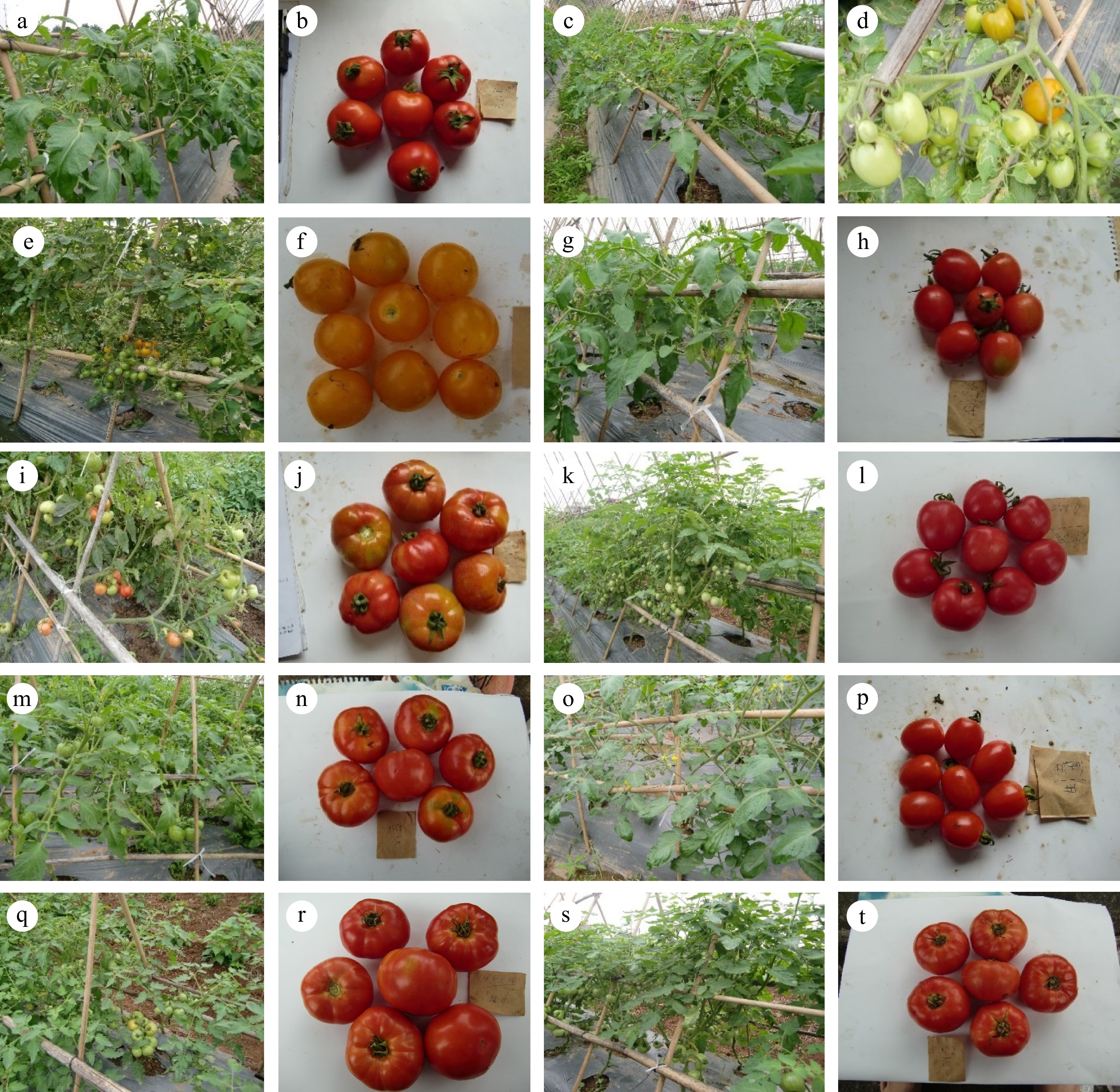
Figure 5.
Plant and fruit shapes of ten potential tomatoes selected at Plant Resouces Center 2023 crop. (a), (b) Caracolli (Plot 4). (c), (d) CLN 2026E (Plot 20). (e), (f) Mini yellow (Plot 27). (g), (h) CL32 (Plot 31). (i), (j) CL38 (Plot 32). (k), (l) Ca chua Thai Lan 1 (Plot 68). (m), (n) CLN 2413R (Plot 45). (o), (p) Ca chua (Plot 47). (q), (r) CLN 1466M (Plot 66). (s), (t) CL1351 B (Plot 69).
Table 6. Resistance to some major diseases on tomato varieties.
Indicator Statistical parameters Level of expression Accessions Expression Quantity (accession) Rate (%) Late blight Not infected 38 76 Plot 4, 20, 47, 66 Less than 20% of leaf and stem area infected 12 24 Plot 3, 11, 14, 28 From 20%–50% of the leaf and stem area is infected 0 0 From 51%–75% of leaf and stem area infected 0 0 From 76%–100% of leaf and stem area infected 0 0 Yellow leaf curl virus disease (% of infected plants) Max = 27.5 0% 19 38 Plot 20, 47, 69 Min = 0 1%–15% 23 46 Plot 4, 32, 45 TB = 6.5 >15% 8 16 Plot 1, 16, 31, 43 CV% = 110 Bacterial wilt
(% of plants infected)Max = 27.5 0% 36 72 Plot 1, 16, 20, 42 Min = 0 1%–15% 12 24 Plot 28, 46, 61 TB = 2.4 >15% 2 4 Plot 28, 59 CV% = 213 Fruit borer
(% damaged fruit)Max = 9 0% 26 52 Plot 4, 16, 20, 31 Min = 0 1%–9% 24 48 Plot 23, 64, 73 TB = 1.6 CV% = 132.3 This is the first study assessing the agronomic characteristics of 50 tomato accessions were conserved at the National Plant Genebank to conserve tomato plant gene resources and select tomato varieties with yield and quality; the harvest time was extended. It diversifies domestic tomato seed sources for production. The initial results have selected ten potential tomato varieties to continue evaluating cultivation methods and fruit quality indicators of these varieties. This result is significant in research and practical application for tomato production in Vietnam.
-
The fifty studied tomato accessions were diverse in manifesting morphological and agronomic traits, and ten potential varieties were selected. They were good fruit quality, attractive shapes, colors, and sizes. During the fruiting period, the plant grew well, without mild infection, with some diseases such as late blight, yellow curl virus disease, and bacterial green wilt. The fruit harvesting period was 17−21 d, and the weight of fruit per plant was ≥ 1.6 kg, the yield reached 18.0−47.9 tons/ha. These accessions were used as material sources to conduct subsequent selective evaluations in tomato variety selection studies for production.
-
The authors confirm contribution to the paper as follows: study conception and design; data collection, analysis and interpretation of results and manuscript preparation: Vuong TAT, Nguyen DT, Nguyen PTT, Hoang NT, Vu CL. All authors reviewed the results and approved the final version of the manuscript.
-
The datasets generated during and/or analyzed during the current study are not publicly available due the project having not yet been completed and details cannot be announced but are available from the corresponding author on reasonable request.
-
The article authors would like to thank the Ministry of Agricultural and Rural Development (MARD) for funding to carry out the research project titled 'Research the effects of harvest time on yield and quality of tomato genetic resources' implementing 2023–2024.
-
The authors declare that they have no conflict of interest.
-
# Authors contributed equally: Tuyet Anh Thi Vuong, Doan Thi Nguyen
- Supplementary Table S1 The list of all the tomato accessions and evaluated morphological and agronomic traits
- Supplementary Table S2 Genetic distance matrix based on 26 agronomic morphological traits of fifty tomato accessions.
- Copyright: © 2024 by the author(s). Published by Maximum Academic Press, Fayetteville, GA. This article is an open access article distributed under Creative Commons Attribution License (CC BY 4.0), visit https://creativecommons.org/licenses/by/4.0/.
-
About this article
Cite this article
Vuong TAT, Nguyen DT, Nguyen PTT, Hoang NT, Vu CL. 2024. Evaluation of morphological characteristics of tomato accessions at the National Plant Genebank in Vietnam. Technology in Horticulture 4: e031 doi: 10.48130/tihort-0024-0025
Evaluation of morphological characteristics of tomato accessions at the National Plant Genebank in Vietnam
- Received: 02 May 2024
- Revised: 21 September 2024
- Accepted: 25 September 2024
- Published online: 05 December 2024
Abstract: The present study aims to evaluate the morphological characteristics of 50 tomato accessions conservating at the National Plant Genebank of Vietnam at Plant Resources Center (PRC), located in An Khanh commune, Hoai Duc district, Hanoi City in the spring-summer season of 2023, to select potential tomato varieties for production. The research methods are National Technical Standards and Testing for tomato plants, including QCVN 01-63:2011/BNNPTNT, QCVN 01-70:2011/BNNPTNT, and characterization and preliminary evaluation for tomatoes issued by the Plant Resources Center. The results showed a remarkable variation in the expression of growth stages from sowing to final harvest. There was significant diversity in morphological traits such as stem type, growth habit, predominant shape, fruit interior flesh color, fruit wall thickness, etc. The fruit yield of the evaluated tomato accessions ranged from 16.5 to 52.6 tons/ha. This study identified ten potential tomato accessions for further studies in breeding varieties for tomato production. The identified tomato accessions exhibit high-quality fruit, diverse fruit sizes, and attractive colors and shapes. The time from sowing to the first harvest ranged from 89 to 103 d, a fruiting rate of over 75%, a harvest time of 17 to 21 d, a total fruit weight per plant over 1.6 kg, and fruit yield reached from 18.0 to 47.9 tons/ha. During the harvest period, these accessions demonstrated robust growth and were resistant to certain diseases.
-
Key words:
- Morphological /
- Characteristics /
- Tomato /
- Collection /
- Evaluations /
- Accessions


